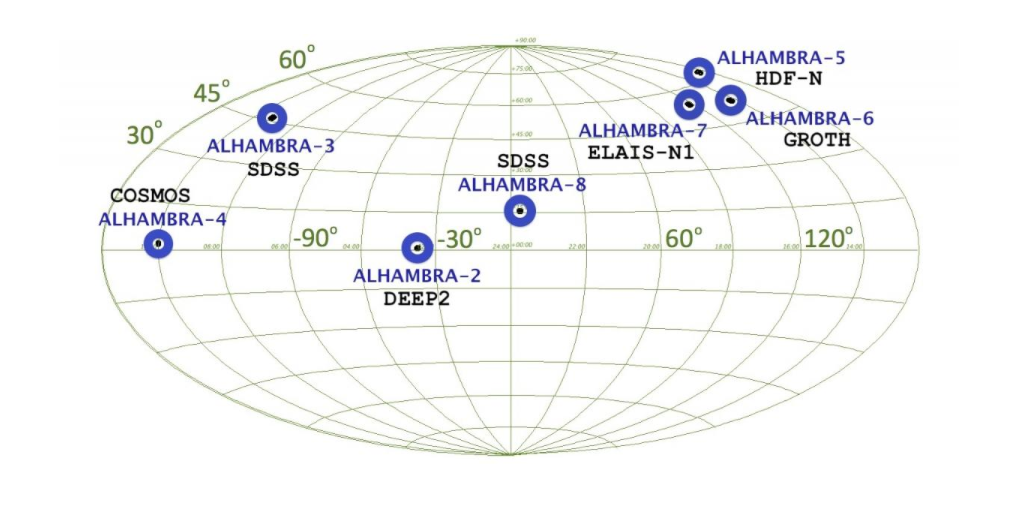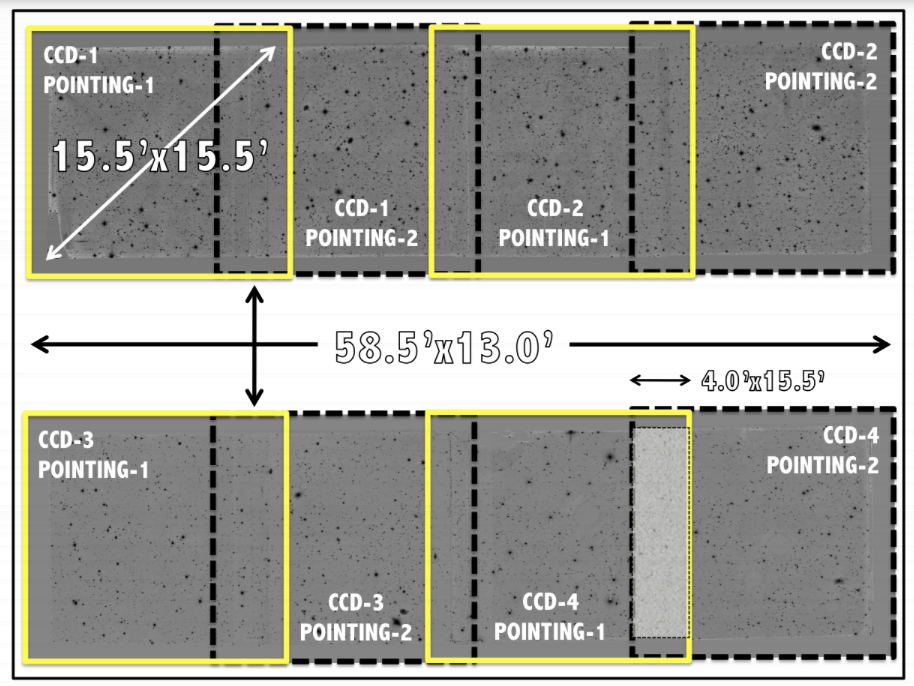

The ALHAMBRA photometric system was specially designed to maximize the effective depth of the survey, in terms of accurate spectral-type and photometric redshift estimations, along with the capability of identification of relatively faint emission lines (Benítez et al. 2009).

The photometric zeropoints were calibrated using stellar transformation equations and refined internally, using a new technique based on the highly robust photometric redshifts measured for emission line galaxies (Molino et al. 2013). Photometric redshifts were derived with the BPZ2.0 code (Benítez 2000, 2013 in prep), which have a precision of δz/(1+zs)=1% for I<22.5 and δz/(1+zs)=1.4% for 22.5 Given the geometrical configuration of the optical imager LAICA, each pointing is composed by four CCDs (as marked with the yellow squares) with an internal gap of ~13.0'. The combination of two contiguous pointing yields a final layout composed by two strips of 58.5'x15.5' (comprising four individual CCDs each). Contiguous CCDs within each strip show a maximum overlap of 4.0'x15.5'. Therefore, the catalogue notation is tied to the corresponding detection image F814W, which is defined by the position it takes within the ALHAMBRA fields.
The figure above illustrates an example of the Pointing Layout for the ALHAMBRA fields
Unique IDs are given to every detection according to the following criteria: ID = 81442100119 stands for 814 (detection image) + 4 (Field) + 2 (Pointing) + 1 (CCD) + 00119 (ColorPro ID). Both astrometric and geometrical information is derived from its corresponding F814W detection image. Kron apertures (RK) and fraction-of-light radii (RF) were settled according to the aperture parameters defined in Molino et al. 2013 (Table D1). Total magnitudes and empirically corrected uncertainties (Molino et al. 2013, Section 3.7) are given by all the 24 filters. Along with this, F814W_3arc represent F814W magnitudes measured on a 3'' circular apertures and ditto F814W_3arc_corr but corrected to tied COSMOS/F814W photometry (Molino et al. 2013, Section 3.5). As every detection in the ALHAMBRA fields was covered by all the 24 filters, nfd indicates the number of filters a source was detected. Whenever a source was not detected, its magnitude was set to 99. and its photometric uncertainty replaced by a 1-σ upper limit (Molino et al. 2013, Section 6.1) suitable for BPZ. Meanwhile, sources not observed were automatically set to -99 with null uncertainties.
The Final Catalogue contains several quality flag. PhotoFlag corresponds to the standard SExtractor photometric flag (Bertin & Arnouts 1996), Satur_Flag indicates a possible saturated source (typically stars with magnitudes brighter than F814W=16), Stellar_Flag represents a source-by-source statistical classification among stars and galaxies (Molino et al. 2013, Section 3.6), irms_OPT_Flag and irms_NIR_Flag indicates the number of optical and NIR bands a detection was observed with a normalized exposure time below its 80%, respectively.
The most probable photometric redshift solution for every source is assigned by zb_1. Additionally, zb_min_1 and zb_max_1 represent the lower and upper limits for the first peak within a 95% interval. Spectral-type classification is given by tb_1 where its number refers to the selected template, as indicated in Molino et al. 2013 (Fig. 21). Odds_1 gives the amount of redshift probability enclosed around the main peak (Molino et al. 2013, Section 4) and Χ2 the reduced chi-squared from the comparison between observed and predicted fluxes according to the selected template and redshift. An estimation of each detection stellar mass content (in units of log10(M_sun)) is given by Stell_Mass_1. M_ABS_1 corresponds to the absolute (AB) magnitude for the Johnson B-band.
Images notation:

Catalogue Description:
References